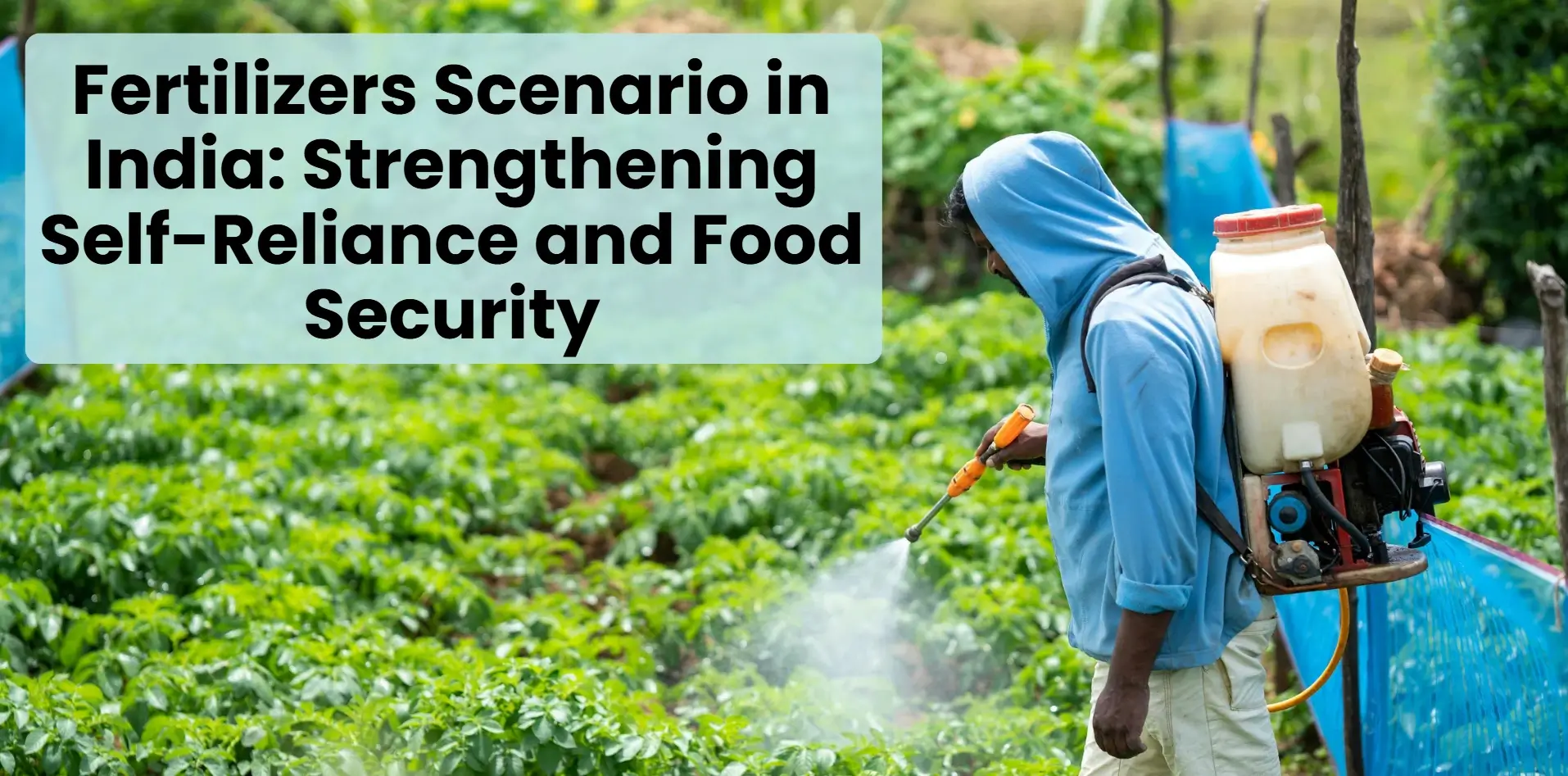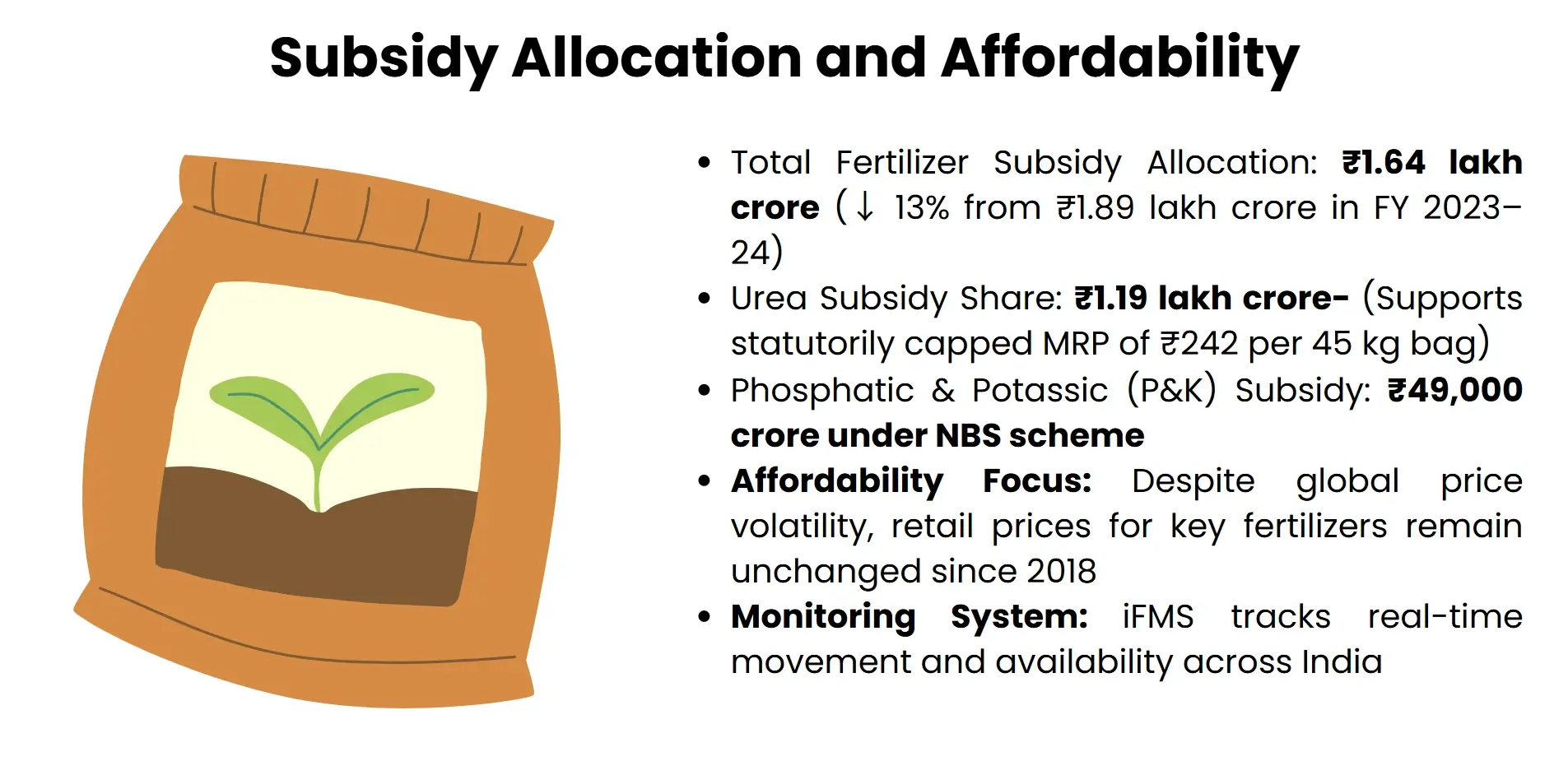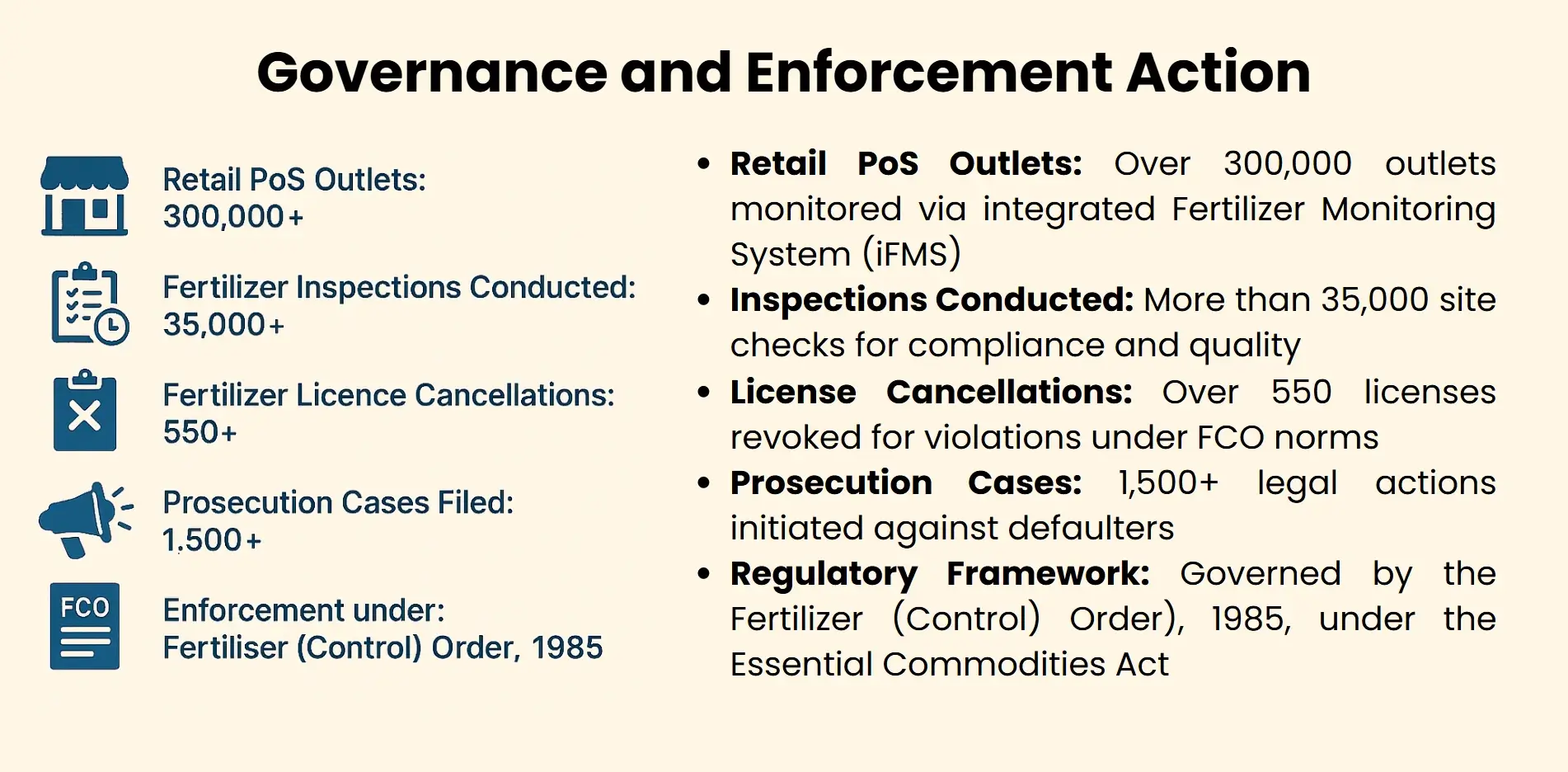The fertilizer industry in India has witnessed stagnant growth, prudent strategy, and a far-reaching approach to the needs of the farmers- timely availability of fertilizers, self-sufficiency, and food security in the country, despite international disturbances.

Access to fertilizers is central to the prosperity of the agricultural backbone of India, alongside national food security and farmer welfare, and therefore, their availability has to be timely and adequate. In recent years, the Department of Fertilizers has gone proactive and science-based to facilitate an uninterrupted supply throughout the season, especially during the peak demand season like Kharif. Formulation and implementation of strong production planning, strategic international collaborations and selective subsidy allocations have helped the government to considerably boost overall capabilities in this sector at least a 35 percent increasein urea and a 44 percent increasein DAP Di-Ammonium Phosphate Fertilizer production.This rise not only fulfils the short-term requirements of the agricultural sector but is closest to the non-recursive future of Atmanirbharta (self-reliance), lessening the reliance on imports and cushioning Indian farmers against global price fluctuations. Even in the face of a global scramble in supply chains, India had an ample supply of fertilizers during Kharif 2025, and stronger sales were easily achieved with no hiccups in supply.In addition to logistics and production, there have been a whole lot of farmer-centred policies that have been made by the government, an effective enforcement system, and even governance reforms, which are aimed at providing affordability, transparency, and equality in access to food. This article examines the dynamic fertilizer scenario in India,describing the key strategic manoeuvrings, production benchmarks and policy breakthroughs that together signify the country as being committed to providing farmers with greater autonomy and ensuring its food security.
Institutional Development and Strategic Planning
The fertilizer sector in India has experienced a strategic changeas a result of scientific planning, institutional coordination and policy innovation.
Scientific Planning of Demand Forecasting Mechanisms
The Department of Fertilizers has highly sophisticated models for forecastingand estimating seasonal as well as regional estimates of fertilizer requirements. These models incorporate agro-climatic, the trend in use of crops, and past consumption data to maximize supply modelling. Technological applications such as the Fertilizer Monitoring System (FMS) and iFMS (Integrated Fertilizer Management System) allow tracking of stock levels, movement, and sales in real-time across a district. The granular visibility can help in eliminating bottlenecks, as well as avoiding the inaccessibility of available fertilizers to farmers at the right time and the right location. This allows the government to reduce wastage and maximize efficiency since it will be able to align production schedules with demand, field by field.
Institutional Synergy and Alignment of Production
Strategic planning is supported by close liaisons encompassing the Department of Fertilizers, PSUs and the private manufacturers. Consultations are done regularly to ensure that production targets are met with reference to national agricultural priorities. Revivals of units that have been discontinued, like that of Hindustan Urvarak & Rasayan Ltd (HURL), have increased the country's output and therefore decreased the imports. Long-term contracts help the government in arranging raw materials such as phosphoric acid and potash at the right time when complex fertilizer production is necessary. Such institutional synergy escalates the supply resilience, particularly in times of global disruptions.

Subsidy Yield and Affordability Insurance
To ensure that the farmers can afford it, the government under schemes such as the Nutrient-Based Subsidy (NBS) and Urea Subsidy Scheme extends large subsidies. Such subsidies go directly to manufacturers and thus fertilizers sell at regulated prices. In FY 2024-25, the allocation towards fertilizer subsidy itself was 2 lakh crore, indicating how much the government wanted to cushion farmers against fluctuating prices on the international scale. The Direct Benefit Transfer (DBT) system promotes transparency and accountability in the authorization of subsidy, and also discourages diversion and misuse.
Online monitoring and policy synergy
Such coordination includes traceability and policy consistency through digital channels such as e-Krishi and AgriStack, which will be integrated with the point-of-sale systems of fertilizer distributors. The platforms connect the data on soil health, crop advisory and fertilizer recommendations to facilitate precision agriculture. Strategic planning is no longer all about logistics rather,it includes linking inputs to sustainability objectives, the welfare of farmers and national food security.
Production Boom and Atmanirbharta
India has made a dramatic shift in its production of fertilizers, and this manifests that the country is on its way towards Atmanirbharta (self-reliance).
Rise in Urea and complex Fertilisers
The historical growth of 35 percent in urea and 44 percent in the production of DAP/NPK was attained in FY 2024-25. This is a result of the commissioning of new plants and the refurbishing of old units of initiatives such as the New Investment Policy (NIP) and the resurrection of closed fertilizer units. Establishments like those run by Hindustan Urvarak and Rasayan Ltd (HURL) at Gorakhpur, Sindri, and Barauni, have brought in a large scope of indigenous capacity, thus reducing the reliance on imports and stabilizing the supply within the country.
Rebooting the Manufacturing Ecosystems at Home
The pressure on self-reliance by the government also encompasses the reorganization of India into a producer of fertilizers. Backward integration of raw materials, strategic investments in green ammonia production, and energy-efficient technologies have shifted the domestic production to sustainable and cost-efficient. The involvement of the Public-private partnership has been central, whereby the private players have increased capacity and converted to best practice in logistics and nutrient blending. Such efforts not only satisfy growing demand but also generate employment as well as economies within the areas.
Strategic Global Partnerships for Raw Materials
Despite the boom in domestic production, India still gets access to crucial raw materials through international long-term partnerships. Contracts or agreements with other countries such as Jordan, Morocco, and Russia, ensure a constant supply of phosphoric acid, rock phosphate,and potash. The forming of such partnerships will be such that it support domestic blending and production, strengthening India regarding its strategic autonomy in fertilizer production. Diversification of routes of sourcing also protects India against geopolitical shocks and price volatility.

Atmanirbharta as a long-term vision
Not only is the production surge an attempt to respond to temporary demand, but it is a vision for the long-term realization of agricultural sovereignty. By enhancing domestic capacity, India is becoming resistant to the global supply chain forces and volatility in price. The focus on the role of indigenous innovation, infrastructure and policy coherence fits within the context of wider objectives, namely food security, empowerment of farmers, and sustainable development.
Kharif 2025: Meeting Demand amid Global Challenges-h3
The effective fertilizer management in Kharif 2025 is an indication of strategic foresight, strong logistics, and flexibility in policies. In spite of disruptions globally, the country was able to ensure a smooth flow of availability and distribution to meet an increased demand in agriculture.
Pro Active stockpiling and Buffer Management
Ahead of the Kharif season, the Department of Fertilizers was able to anticipate and make pre-stockpiling in the high consumption areas, informed by predictive analytics and district-level usage data. The norms under the Buffer system were altered to cater to the expected surges in demand, particularly that of urea and DAP. Warehousing infrastructure was also improved in prominent agricultural states such as Uttar Pradesh, Maharashtra, and Tamil Nadu and guaranteeing that fertilizers hit the stores long before the sowing commenced. This decentralized system reduced transit delays of transit provided a quick replenishment.
Navigating around Global Supply Chain
The fertilizer markets around the world in 2025 were characterized by volatility because of geopolitical tensions, the bottlenecks in shipping, and raw materials scarcity. Diversified import sourcing and strategic reserve were what India had to counter these risks. In the long run,Oman, Saudi Arabia and Morocco were contracted, thus importing a constant supply of the phosphatic and potassic fertilizers. Also, the state focused on an increase in domestic production to minimize the risks of exposure to global price fluctuations. These allowed supply and prices to remain stable throughout the season.
Meeting demand withoutshortage
Kharif 2025 was a good year in terms of consumption of fertilizers due to an enlarged sowing base and the positive prediction of the monsoons. No major shortages were reported in spite of the surge. The use of the Integrated Fertilizer Management System (iFMS) in real-time monitoring allowed the redistribution of supplies to deficit areas. States such as Punjab, Madhya Pradesh, and Odisha had an above-average level of sales but did not have any breaks in supplies. It is this success that highlights the efficacy of information technology in the logistics and harmonized government system.
Farmer-Centric Distribution and Outreach
PoS networks were increased by the government to promote fair access to availability, and the cooperatives and agri-retail outlets were strengthened as part of the last-mile delivery. The awareness campaigns informed farmers on the best methods of using fertilizers and maintaining soil health and decreased excessive fertilization, and encouraged better yields. Helplines and mobile apps gave an immediate update on the availability, allowing the farmers to plan purchases effectively. All these efforts have served to alleviate panic purchases and enhance confidence.
Governance, Enforcement and Welfare of farmers
The fertilizer policy framework in India, in 2025 is showing highly principled governance ethos, strict enforcement approach, and sound dedication to the cause of the farmer.

Intensifying the institutional oversight and transparency
Digital integration and coordination among agencies has strengthened institutional governance by the Department of Fertilizers. Beneficiary enabling systems such as the integrated fertilizer management system (iFMS) and the Direct Benefit Transfer (DBT) on the fertilizer manage real time monitoring of fertilizers in the pipeline, their sales and the subsidy amount. The system's ultimate goal is to improve supply chain transparency bypreventing leaks and diversion. Frequent audit and dashboard-based monitoring enable central and state authorities to act quickly in case of isolation.
Action on Hoarding and Black Marketing
To save farmers against artificial deficiency and price manipulation, duplication and unpermitted diversion have been tightened by the government. The check by agricultural departments and district administrations in joint operations has resulted in the confiscation of illicitly stored fertilizers as well as the revocation of licenses of defectors. The FCO is correctly enforced and the punishment that comes with its defiance includes jailing and fines. Such moves give an explicit message that fertilizer allocation should be just, legal, and farmer-oriented.
Farmer-Centric Policy and Outreach
In fertilizer governance, farmer welfare continues to take a predominant place. The government has extended the PoS systems to more than 300,000 outlets making it convenient to verify a transaction in digital format. Backed up with awareness programs of balanced use of nutrients, soil health and use of fertilizer as per crop requirement, the awareness programs are carried out to a large extent in Krishi Vigyan Kendras (KVKs) and other means. Such undertakings are able to equip farmers with knowledge, minimize the costs of inputs and optimize yields.
Fertilizer Policy in Food Security
The goals of comprehensive food security are increasingly driving fertilizer governance. The new policies have focused on sustainable management of nutrients, less use of chemicals, and the establishment of the use of bio-fertilizers. The National Mission on Sustainable Agriculture (NMSA) provides a collective approach to fertilizer strategy, climate resilience, and soil conservation. By providing quality fertilisers in a timely manner and influencing their responsible use, the government protects productivity and ecological health.
Conclusion
The story of the Indian fertilizer industry in 2025 becomes the mark of far-sighted planning, strong governance, and an uncompromising approach towards serving farmers. The Department of Fertilizers has taken scientific planning, a strong production growth and focused subsidy support to ensure that the fertilizers reach every farmer in the country timely and equitably- irrespective of the global disruptions. The all-time high production of urea and DAP/NPK, an ability to establish strategic alliances with foreign companies, is envisaged as a gradual process of Atmanirbharta that enhances national food security and controls agricultural sovereignty.This showed the success of these undertakings as higher sales were met without shortages, as seen at Kharif 2025. Stamping out on hoarding, digital reporting, and farmer-first outreach has also acted as a further endorsement of trust and accountability. In the journey towards India, incorporating sustainability, innovation, and climate-resilient aspects into the policy regarding fertilizers will enable farmers to empower the agricultural future of the country. The fertilizer environment is no longer a discussion of inputs alone, rather it entails comprehensive growth, ecological, as well as self-sustainability.